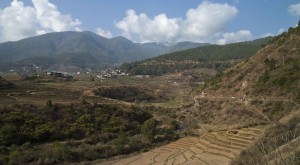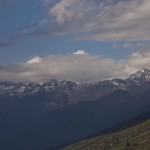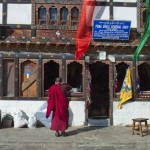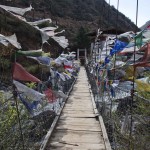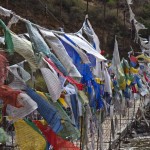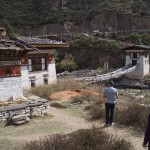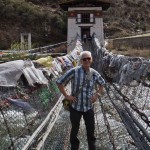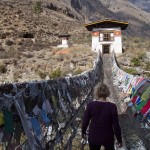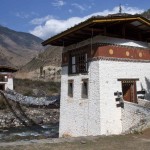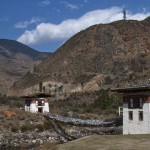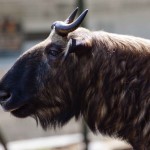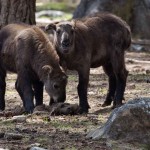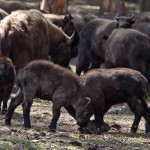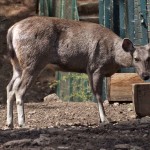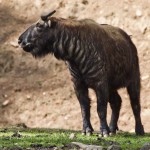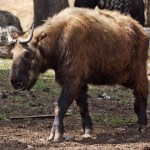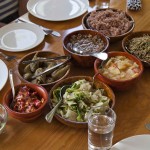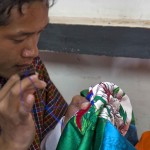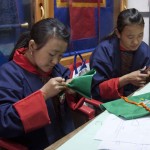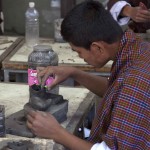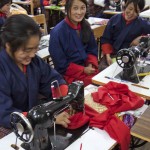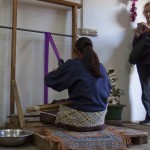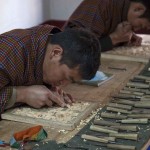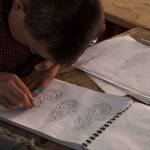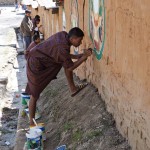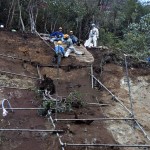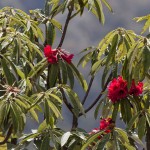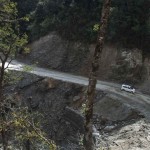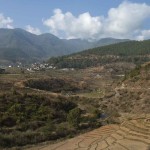This morning it was back on the bumpy, windy, dusty road that is the National Highway of Bhutan from Punakha to Paro. Nice to know that even the royal family has to use this road – there is no helicopter short cut for them! Our challenge was to get to the section of major roadworks by 10am, which is when the road opened again for 30 minutes, otherwise we would have to wait until midday. Our driver timed it well, and we arrived with enough to spare to stretch our legs and look at the scenery as the cars, vans and trucks formed an orderly, snaking line down the mountain.
National Arts School
In Thimphu we visited the National Arts School. This institution runs six-year courses in all thirteen of the national arts of Bhutan: papermaking; stonework; blacksmithing; clay arts; painting; bronze casting; wood, slate and stone carving; woodturning; woodworking; weaving; silver and gold-smithing; cane and bamboo work; and needlework. One of the wonderful things about this country is that, due to the laws about traditional architecture and costume, these artists will actually have employment when they graduate. Not many countries can offer their artists such futures.
We visited different year groups of a couple of the arts to check out the development of skill throughout their studies. Teachers and students were completely engrossed in their work, at ease with the visitors wandering through the lessons in fascination.
Motithang Takin Preserve
After a lunch in Thimphu that included one of the nicest chilli-cheese dishes of our travels thus far and some pretty delicious vegetarian momos, we mad a slight detour to the Motithang Takin Preserve. The takin is Bhutan’s national animal and is unlike anything we have seen before. Well, to be honest, we’ve seen elements of this creature before, just not all in the one beast. Legend has it that during a religious lecture “the Divine Madman” was begged by those in attendance to conjure a miracle before them. He agreed, as long as he was fed a whole cow and a goat for lunch. The animals were brought to him and he devoured all but the bones. He then put the head of the goat on the skeleton of the cow and did his magic, and voila, the creature lived. They are such tame creatures, that even when they were given their freedom when the zoo was abolished some years ago, they didn’t go back to the wild, they just wandered around Thimphu looking for food. So the king created the current preserve of over 8 acres to keep them safe.
Iron Chain Bridge
With our minds still on the large furry creatures we had just seen, we continued on our way towards Paro. Not far from our final destination we stopped at the iron chain bridge built by Thangtong Gyalpo (1385-1464) – the first person to use iron chain in the building of suspension bridges. He built 108 of these bridges throughout Tibet and Bhutan earning him the name Iron Bridge Lama (Lama Chakzampa). The traditional iron bridge here was reconstructed in 2005 using some of Thangtong’s original chain links. It’s an unusual and exhilarating experience crossing the river on a bouncy, see-through bridge, but I am sure it would not be quite so exhilarating if the bridge were of any significant height! It was also surprisingly effective and economical – basically a mesh of really strong chicken wire strung in a u-shaped corridor, and that was pretty much it.
A relaxing afternoon was had back at Gangtey Palace (our first stop when we arrived in Bhutan) sipping some Druk beer in the restaurant lounge admiring the view of Paro. I followed this up with a therapeutic massage before dinner – combined with a lovely and plentiful meal and a good night’s sleep, it was the perfect preparation for climbing Tiger’s Nest Monastery the next day.
Cost of visiting Bhutan
Most people are under the misapprehension that Bhutan has a cap on the number of visitors per year. This is not the case – they do have a daily fee of $250 USD pp for being in the country, but that covers your accommodation, meals, guide and driver, as well as contributions to the health and education of its citizens. The accommodation is of a 3 star quality, and you can pay an additional supplement if you are interested in staying somewhere more luxurious. Tourists are not permitted to ‘go off’ on their own (for activities such as trekking), and your guide and driver take you wherever you wish to go in the country, following an itinerary planned with you prior to travel. The cost and these restrictions are Bhutan’s way of preventing the country from becoming a ‘backpacker ghetto’ – they have no desire to be the next Nepal, and in fact, it is illegal to climb any mountains in Bhutan higher than 6,000m (they have the highest ‘unclimbed’ mountain in the world – Gangkhar Puensum, 7,570m).
Our Bhutan story continues…
Read our full Bhutan story here:
Part 1: Paro
Part 2: Paro Tshechu Festival
Part 3: Thimphu
Part 4: Punakha
Part 5 (current): National Highway
Part 6: Tiger’s Nest
Our guide was Pema Namgay and we arranged our trip through Blue Poppy Tours
Click on any image below to view as gallery
- The distant Himalayas, Bhutan
- A monk on his phone, Paro, Bhutan
- More prayer flags on the wooden suspension bridge, Paro, Bhutan
- Prayer flags on the wooden foot bridge, Paro, Bhutan
- Safely on the other side of the iron chain bridge, Paro, Bhutan
- John on the iron chain bridge near Paro, Bhutan
- Peace flags covering the iron chain bridge, Bhutan
- Close up of iron chain bridge, Bhutan
- Iron chain bridge near Paro, Bhutan
- Close up of a takin at Motithang Takin Preserve, Bhutan
- A pair of baby takins at Motithang Takin Preserve, Bhutan
- Baby takins at Motithang Takin Preserve, Bhutan
- A deer at Motithang Takin Preserve, Bhutan
- Observant takin at Motithang Takin Preserve, Bhutan
- A takin at Motithang Takin Preserve, Bhutan
- Lunch at Thimphu, Bhutan
- Excellent eyesight work embroidering at the National Arts School, Bhutan
- Embroidery class at the National Arts School, Bhutan
- Pottery class at the National Arts School, Bhutan
- Good old fashioned sewing machines at the National Arts School, Bhutan
- Nic photographing a weaver at the National Arts School, Bhutan
- Woodcarving at the National Arts School, Bhutan
- Drawing at the National Arts School, Bhutan
- Decorating the walls of the National Arts School, Bhutan
- Roadworks, Bhutan
- Roadside rhododendren, Bhutan
- National Highway, Bhutan
- View from the National Highway, Bhutan

